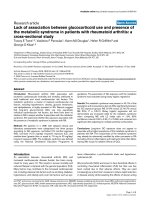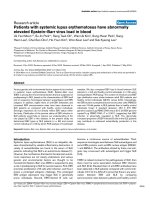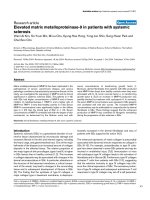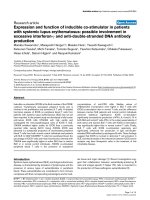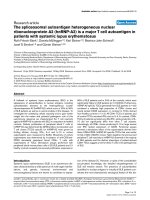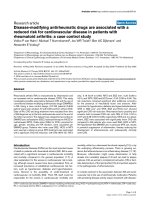Jaccoud’s arthropathy in patients with systemic lupus erythematosus: One centre study
Bạn đang xem bản rút gọn của tài liệu. Xem và tải ngay bản đầy đủ của tài liệu tại đây (342.44 KB, 6 trang )
Journal of Advanced Research (2011) 2, 327–332
Cairo University
Journal of Advanced Research
ORIGINAL ARTICLE
Jaccoud’s arthropathy in patients with systemic
lupus erythematosus: One centre study
Iman H. Bassyouni a,*, Mohammed A. Mashahit b, Rasha H. Bassyouni c,
Nermin H. Ibrahim d, Naglaa A. El-Sherbiny e, Eman M. El-Tahlawy f
a
Rheumatology and Rehabilitation Department, Faculty of Medicine, Cairo University, Egypt
Internal Medicine Department, Faculty of Medicine, El-Fayoum University, Egypt
c
Medical Microbiology and Immunology Department, El-Fayoum University, Egypt
d
Medical Microbiology and Immunology Department, Bani_Swif University, Egypt
e
Public Health and Community Medicine Department, El-Fayoum University, Egypt
f
Public Health and Community Medicine Department, National Centre Research Institute, Egypt
b
Received 15 July 2010; revised 12 February 2011; accepted 16 February 2011
Available online 17 March 2011
KEYWORDS
Systemic lupus
erythematosus;
Deforming arthropathy;
Jaccoud’s arthropathy;
Anti-phospholipid
syndrome;
Sicca syndrome
Abstract Jaccoud’s arthropathy (JA) is a chronic, deforming, non-erosive arthropathy occurring
in a subset of patients with systemic lupus erythematosus (SLE). In this research we aimed to evaluate clinical and immunological features in patients with SLE complicated by JA. Eighty seven consecutive SLE patients with a history of arthritis were included in the present study. These patients
were subdivided according to ‘‘Jaccoud’s arthropathy index’’ as follows: non-deforming arthropathy, mild deforming and definite Jaccoud. Demographic data, disease activity and disability were
recorded. Rheumatoid factor (RF), anti-cardiolipin antibodies (ACL), antiSSA/Ro, and anti
SSB/La antibodies, were assessed in all patients. We found clinical deforming arthropathy in 12
patients, among whom seven had definite JA. Both the mean duration of the disease and of arthritis
were longer in the JA group compared to the non-deforming arthropathy group. JA patients
presented a trend toward a lower quality of life. The prevalence of Sicca syndrome (SS) and
antiphospholipid syndrome were significantly higher in the JA group than in the patients with
non-deforming arthropathy (p = 0.011 and 0.012, respectively). ACL and RF were more frequent
* Corresponding author. Tel.: +20 123476767; fax: +20 2 37228788.
E-mail address: (I.H. Bassyouni).
2090-1232 ª 2011 Cairo University. Production and hosting by
Elsevier B.V. All rights reserved.
Peer review under responsibility of Cairo University.
doi:10.1016/j.jare.2011.02.005
Production and hosting by Elsevier
328
I.H. Bassyouni et al.
among patients with JA (p = 0.013 and 0.036; respectively). These data suggest that JA is not rare
and represents a subset of SLE with specific clinical and serological features. Future studies are
needed to reveal the pathogenesis, the genetic association, the prevention, the stabilization and
the appropriate cure for these patients.
ª 2011 Cairo University. Production and hosting by Elsevier B.V. All rights reserved.
Introduction
Joint involvement in systemic lupus erythematosus (SLE) is
one of the earliest and most common manifestations of this
multi-systemic disease [1]. Lupus arthropathy is usually transient, migratory, non-erosive and reversible [2]. Occasionally,
it may take a more chronic course, leading to non-erosive joint
deformities, although erosive features indistinguishable from
rheumatoid arthritis occur rarely [3].
Non-erosive arthropathy with marked articular dislocation
or subluxation has been first described by Jaccoud in patients
with rheumatic fever. Later investigators have reported complications of Jaccoud’s arthropathy (JA) in other rheumatic
diseases such as SLE [1–3]. JA has not been adequately evaluated because it is more easily manageable compared to lifethreatening involvements such as renal disorders [1].
Given the wide variety of clinical features associated with
SLE, there have been many attempts to identify subsets of patients for whom a given antibody specificity can be identified
with JA. Several associations, such as the presence of antibodies against U1 RNP, RA 33, SS-A/Ro and SS-B/La, anti cardiolipin (aCL), lupus anticoagulants (LAC), and anti-mutated
citrullinated vimentin, have been reported previously [1,4,5].
To our knowledge, no previous studies had dealt with the
description of JA and its relation to clinical and immunological profiles among Egyptian SLE patients with arthritis. In
that field, well-designed replication studies in populations with
different ethnic backgrounds are necessary.
In this research, we aimed to evaluate clinical and immunological features in patients with SLE complicated by JA.
Patients and methods
A group of 87 consecutive patients affected by SLE with a documented history of arthritis were prospectively assessed. They
all attended the Department of Rheumatology and Rehabilitation Kasr El-Eini Hospital, Cairo University, and fulfilled the
American College of Rheumatology (ACR) criteria for the
diagnosis of SLE [6]. There were 83 women and four men with
a mean age of 25.07 ± 6.77 years (14–47 years); the mean
duration of SLE was 7.20 ± 4.06 years (5–17 years). Disease
activity was assessed for all the patients using the SLE disease
activity index (SLEDAI) [7]. The definition of JA had been
based on clinical criteria (reversible articular deformities) together with the absence of bone erosions on radiographs.
These patients were clinically evaluated, underwent a detailed
physical examination and had their medical records revised.
Articular evaluation
Physical examination included a detailed standardized examination of the hands and feet. The following items were evaluated in each case: signs of arthritis of wrists and small joints of
the hand, ulnar deviation of fingers, MCP subluxation, swan
neck deformities of the fingers, Z deformity of the thumb, boutonnie`re deformities and deformities of the feet. Previous history with special attention to the presenting manifestation of
SLE, cumulative ACR criteria, and time between arthritis
and the development of deformity, were obtained from medical records. Deforming arthropathy was considered positive
if there is deviation from any of the metacarpus finger axes (assessed with an angle goniometer) [8]. Those patients were then
assessed for the presence of definite Jaccoud’s arthropathy,
using a JA index [9], which is dependent upon the different
clinical symptoms and the severity of the deformities (details
in Table 2). Patients who had scores exceeding five points were
considered to have JA. The remaining patients were classified
as having mild deforming arthropathy. Assessment of disability was done using the Health Assessment Questionnaire
Disability Index (HAQ-DI) [10]. All the patients had recent
X-ray film of the hands (postero-anterior view).
Organ system assessment
Clinical features were defined according to the ACR 1982 revised classification criteria for SLE [6]. Neuropsychiatric manifestations were defined according to the ACR nomenclature and
case definitions for neuropsychiatric lupus [11]. Renal involvement was defined as glomerulonephritis on biopsy or with diastolic blood pressure >90 mm Hg, edema requiring diuretic
therapy, proteinuria >0.5 g/24 h, abnormal urinary sediment
manifested by RBC and leukocytes, creatinine clearance
<60 ml/min or raised serum creatinine level >124 umol/l. Renal biopsy was available for 22 patients and evaluated according
to the World Health Organization (WHO) classification of histological types of lupus nephritis [12]. Antiphospholipid syndrome was considered to be present if at least one of deep
venous thrombosis (DVT), arterial thrombosis confirmed by
Doppler imaging, or pregnancy morbidity was present, in addition to the presence of LAC and/or aCL [13]. Other organ system
affections were defined as previously described [14].
Laboratory and immunological investigations
Routine laboratory examinations were collected from the patients’ records. Detection of IgM rheumatoid factor (RF)
was done by latex agglutination (Rose-Waaler test), antinuclear antibody (ANA) by indirect immunofluorescence on
Hep-2 cells, and anti double stranded DNA (anti-dsDNA)
antibody using a modified Farr assay. Anti-Ro/SSA and
anti-La/SSB were searched by immunodiffusion (ImmunoConcepts, Sacramento, CA, USA). Anti-cardiolipin antibodies
(aCL) were detected by ELISA using commercial kit (ImmunoConcepts, Sacramento, CA, USA). Lupus anticoagulants
(LAC) were assessed by the dilute Russell’s viper venom time
and confirmatory tests [15].
Jaccoud’s arthropathy in SLE
329
The study was approved by our institutional ethics committee and informed consent was obtained from all the patients.
Statistical analysis
The statistical package for social sciences (SPSS) version 10
(LEAD Technology Inc., Charlotte, NC, USA) was used to
analyze the data. Data were statistically described in terms
of range, mean ± standard deviation (±SD), frequencies
(number of cases) and relative frequencies (percentages) when
appropriate. Statistical analysis was performed using the chi
square method with Yates’ correction, Fisher’s exact test.
The Student t-test was used to compare the differences of the
mean of two groups in ordinal variables. A difference was considered to be statistically significant when the probability (p)
value was <0.05.
Results
We identified 12 patients with clinical deforming arthropathy
of the hands. Among them, seven patients had a JA index
greater than five points (>5) and were considered to have definite JA.
The mean age of JA patients was insignificantly different
compared to patients with mild deformity and those with
non-deforming arthropathy. Both the disease duration and
the duration of arthritis were longer in JA patients than in
those with non-deforming arthropathy (p = 0.000 and 0.04,
respectively).
Lupus activity using a SLEDAI score was comparable between the three groups. The mean score of the disability was
higher in the JA group compared to the other groups; however, differences were not significant (p > 0.05). Demographic
data, activity and disability of the three types of arthritis are
presented in Table 1.
Arthritis was presented as the initial disease manifestation
in six out of seven JA patients. Their early symptoms consisted
of morning stiffness and/or minimal to mild arthralgias and
the duration from the initial joint symptoms to the typical
deformity was 12.5 ± 5.3 years.
The JA index and articular indices of the two types of
deforming arthropathy are presented in Table 2. Foot involvement was observed in three patients of the JA group, two had
hullux valgus and one had metatarsophalangeal joint sublaxation. Laxity of ligaments, other than those of hands and feet,
were not observed in any other joints of the body.
The radiological findings of the wrists in the JA group included joint space narrowing in one patient, cystic changes
Table 1
in two patients, bone irregularity in two patients, and ulnar
laxation in one patient. Bone irregularities, cystic changes,
and MCP hooks, were found in the fingers of three
patients.
In order to evaluate whether JA patients constitute, apart
from the presence of deformities, a distinct subgroup within
the range of SLE, we compared the clinical characteristics
and serological findings of seven patients with definite JA
and with those of the group of our SLE population with
non-deforming arthropathy (Table 3). Renal affection was
present in 52/87 patients of our patient cohort; none of our patients suffered from chronic renal failure. Renal affection was
less frequent among the JA group than the non-deforming
group; however, the difference was insignificant (p = 0.08).
The prevalence of Sicca syndrome (SS) and antiphospholipid
syndrome were significantly higher in the JA group compared
with the patients with non-deforming arthropathy (p = .0.011
and 0.012, respectively). ACL and IgM RF were more frequent
among patients with JA (p = 0.013 and 0.036; respectively).
No significant differences were found with respect to other
clinical and serological characteristics between the two groups.
The group with mild deforming arthropathy did not differ statistically in any aspect (from the SLE patients without deforming arthropathy (data not shown).
Discussion
Joint involvement occurs in the majority of patients with SLE
and is one of the initial manifestations, ranging from minor
arthralgia to severe deforming arthritis, or so-called JA [1].
JA of the hands was identified in seven (8%) of our series of lupus patients with arthritis. JA is noteworthy to be recognized
since it is difficult to manage and may trouble patients’ quality
of life [16]. The estimated prevalence of JA in the published literature ranged from 3% to 10% according to the population
studied and their criteria of patient selection [5,9,16,17]. JA
was first described in 1867 in patients with rheumatic fever
[18]; later it was observed in patients with SLE [5,9,16,17], in
other connective tissue diseases [19–21], and in other different
clinical conditions [22–24]. Regardless of the associated disease
condition, the etiopathogenesis of JA is still unknown. In the
present series of SLE patients, it was observed that the group
with JA had a significantly longer duration both of the disease
and of arthritis compared to the non-deforming group. Spronk
et al. have observed that high disease activity for prolonged
periods of time may lead to the development of hand deformities [9]. Furthermore, previous studies have confirmed that typical JA appears to be a late manifestation of longstanding
Demographic data, activity and disability of the three types of arthropathy.
Patient characteristic
Mild deforming (n = 5)
Jaccoud’s (n = 7)
Non-deforming (n = 75)
Age (years)
Disease duration (years)
Arthritis duration
SLEDAI
HAQ-DI
25.0 ± 4.52
6.20 ± 2.40
5.97 ± 3.61
12.80 ± 8.50
1.2 ± 0.7
27.57 ± 7.76
13.28 ± 2.65a,b
9.62 ± 4.97b
13.57 ± 9.08
1.5 ± 1.2
25.12 ± 6.91
6.65 ± 3.68
5.61 ± 4.93
17.45 ± 8.36
0.9 ± 0.9
Data are mean ± SD.
SLEDAI = systemic lupus erythematosis disease activity index, HAQ-DI = Health Assessment Questionnaire Disability Index.
a
Significant compared to mild deforming group.
b
Significant compared to non-deforming group.
330
Table 2
I.H. Bassyouni et al.
Jaccoud arthropathy index of the hand of two types of deforming arthropathy.
Jaccoud arthropathy index
Swan neck deformity
1–4 fingers (2 points)
5–8 fingers (3 points)
1–4 fingers (2 points)
5–8 fingers (3 points)
1–4 fingers (2 points)
5–8 fingers (3 points)
1–4 fingers (2 points)
5–8 fingers (3 points)
One thumb (1 point)
Both thumbs (2 points)
Ulnar deviation
Boutonnie`re deformity
Limited MCP extension
Z deformity
Mild deforming patients
no (n = 5)
Jaccoud’s patients no
(n = 7)
1/5
0/5
2/5
0/5
1/5
1/5
2/5
0
1/5
1/5
3/7
3/7
4/7
2/7
3/7
1/7
2/7
2/7
1/7
1/7
MCP = metacarpophalangeal joints.
Table 3 Clinical and immunological characteristics of the
three groups of patients with lupus arthropathy.
Mild-deforming Jaccoud Non-deforming
(n = 5)
(n = 7) (n = 75)
ACR criteria of SLE
Malar rash
Discoid rash
Photosensitivity
Oral Ulcers
Arthritis
Serositis
Renal disorders
Neuropsychiatric
Haematological disease
Anti-nuclear ab
Anti-dsDNA
2
1
2
2
5
2
2
1
1
5
2
(40)
(20)
(40)
(40)
(100)
(40)
(40)
(20)
(20)
(100)
(40)
4
0
4
2
7
5
2
1
3
7
3
(57.1) 45 (60)
8 (10.6)
(57.1) 47 (62.6)
(28)
27 (36)
(100) 75 (100)
(71.4) 51 (68)
(28)
48 (64)
(14.2) 13 (17.3)
(42.8) 16 (21.3)
(100) 75 (100)
(42.8) 51 (68)
Other clinical manifestations
Anti-phospholipid
1 (20)
syndrome
Sicca syndrome
1 (20)
Cardiopulmonary
1 (20)
Cutaneous vasculitis
1 (20)
3 (42.8)* 4 (5)
2 (28)
26 (34.6)
3 (42.8) 14 (18.6)
Other serological findings
RF (IgM)
1
aCL (IgG and/or M) 1
LAC
1
Anti-Ro/anti-La
1
3
5
3
3
(20)
(20)
(20)
(20)
4 (57.1)* 9 (12)
(42.8)*
(71.4)*
(42.8)
(42.8)
7 (9)
17 (22.6)
9 (12)
13 (17.3)
Data are number of patients (%); anti-dsDNA, anti-double stranded DNA; RF, rheumatoid factor; aCL, anticardiolipin; LAC,
lupus anticoagulant.
*
Significantly different compared to the non-deforming group.
arthritis [1,25,26]. Therefore, we believed that lupus activity
occurring over a long duration together with persistent tenosynovitis, might cause capsule retraction and ligamentous laxity leading to muscle imbalance, with subsequent
development of JA [1,25]. Based on histological findings,
microvascular changes and mild but typical fibrous synovitis
with little or no round cell infiltration have been found in JA,
which have been mainly located in the articular capsule and
tendons, leading to later fibrosis and deformity [17]. These findings have been confirmed by ultrasonographic and magnetic
resonance imaging (MRI) of the hands in JA where capsular
swelling, and edematous and proliferative tenosynovitis were
the most prominent findings [26,27]. Recently, Sa´ Ribeiro
et al. have performed a detailed MRI analysis of the hands of
20 patients with JA secondary to SLE. They found some degree
of synovitis, bone cysts, subchondral bone edema, and tiny
areas of erosion, which were not detected on conventional
radiographs of the hands [28].
Previous published studies have shown conflicting results
with respect to the association of JA with auto antibodies in
lupus patients. Rheumatoid factor and ACL were found associated with JA in our patient cohort. A possible role for RF
has been suggested in the pathogenesis of JA by participating
in the formation of immune complexes and, as such, acting as
a local inducer of an inflammatory reaction [1]. Numerous
authors have observed that the patients with JA frequently display elevated C-reactive protein [9], RF [1], anti-cardiolipins
[1,17,29], anti-SSA/Ro and anti-SSB/La antibodies [8,30]. Another study has demonstrated an association between JA in the
patients with SLE and anti-thyroglobulin antibodies [31]. A recent study conducted in Brazil comparing the frequency of various autoantibodies such as anti-dsDNA, anti-SSA/Ro, antiSSB/La, anti-cyclic citrullinated peptides and anti-mutated citrullinated vimentin in SLE patients, with or without JA, found
no statistically significant differences between the groups except for anti-dsDNA and anti-mutated citrullinated vimentin
antibodies [5]. The variable results presented in the literature
might be related to ethnical or methodological differences.
Whether these antibodies have an etiopathogenic role in JA
is still entirely unknown.
We described an association of anti-phospholipid syndrome
and JA. Van Vugt et al. [17] have previously described such an
association and have suggested that small vessel vasculopathy
may play a part in the genesis of the periarticular fibrosis. A
growing body of evidence for this hypothesis can be found in
‘‘fibrin like material obliterating small vessel lumens’’
described in synovial biopsy specimens [32]. Bywaters [18]
has already reported a correlation with mitral stenosis and
Libman-Sacks endocarditis; both are known to be associated
with antiphospholipid syndrome. One recent study has demonstrated an association between the presence of valvular heart
disease and JA in the patients with SLE [33].
The high prevalence of SS in our patients with JA was consistent with previous observations [4,8,34]. Villiaumey et al.
Jaccoud’s arthropathy in SLE
[35] have reported the association of SS and JA in collagen diseases and raised the possibility that lacrimal and salivary gland
involvement in SS can reflect a systemic disorder, including
synovial inflammation, which may lead to a capsulo-ligamentous dislocation or JA.
The association between lupus nephritis and JA is, however, unclear: Van Vugt et al. have found renal affection to
be significantly less in their JA group with SLE than the
non-deforming group [17]. On the other hand, Zeier has described a case with glomerulonephritis and JA and coined
the term Jaccoud’s nephropathy [36]. A close association has
been described between the presence of chronic renal failure
complicated by secondary hyperparathyroidism in SLE patients, and responsibility for tendinous elongation and/or Jaccoud’s syndrome [37]. The rarity of renal involvement and
chronic renal failure in our JA patients might be related to
the elevated RF, which has been considered as a protecting
factor against renal affection [29].
Conclusion
To sum up, in our patients with lupus arthropathy JA is not
rare and seems to be more frequent among patients with long
disease duration. JA patients presented a trend toward a lower
quality of life (using HAQ-DI) compared with the patients
with SLE without deforming arthropathy. JA is notable for
positive association with IgM RF, SS, anti-phospholipid syndrome, with unique radiological features, and foot involvement. On the other hand, those with a ‘‘mild deforming
arthropathy’’ do not seem to differ in any respect from SLE
patients without deforming arthropathy. Future multicentre
studies, on a larger cohort, are needed to reveal the pathogenesis, the genetic association, the prevention, the stabilization
and the appropriate cure for these patients.
References
[1] Pipili C, Sfritzeri A, Cholongitas E. Deforming arthropathy in
systemic lupus erythematosus. Eur J Intern Med
2008;19(7):482–7.
[2] Pipili C, Sfritzeri A, Cholongitas E. Deforming arthropathy in
SLE: review in the literature apropos of one case. Rheumatol Int
2009;29(10):1219–21.
[3] Fernantez A, Quintana G, Rondn F, Restero J, Sanchez A,
Matteson E. Lupus arthropathy: a case series of patients with
rhupus. Clin Rheumatol 2006;25:164–7.
[4] Takeishi M, Mimori A, Suzuki T. Clinical and immunological
features of systemic lupus erythematosus complicated by
Jaccoud’s arthropathy. Mod Rheumatol 2001;11:47–51.
[5] Galvao V, Atta AM, Atta ML, Motta M, Dourado S, Grimaldi
L, et al. Profile of autoantibodies in Jaccoud’s arthropathy.
Joint Bone Spine 2009;76(4):356–60.
[6] Tan EM, Cohen AS, Fries JF, Masi AT, McShane DJ, Rothfield
NF, et al. The 1982 revised criteria for the classification of
systemic lupus erythematosus. Arthritis Rheum 1982;25:1271–7.
[7] Bombardier C, Gladman D, Urowitz M, Caron D, Chang C.
Derivation of the SLEDAI A disease activity index for lupus
patients. The Committee on Prognosis Studies in SLE. Arthritis
Rheum 1992;35:630–40.
[8] Alarcon-Segovia D, Abud-Mendoza C, Diaz-Jouanen E,
Iglesias A, De Los Reyes V, Herna´ndez-Ortiz J. Deforming
arthropathy of the hands in systemic lupus erythematosus. J
Rheumatol 1988;15:65–9.
331
[9] Spronk P, ter Borg E, Kallenberg C. Patients with systemic
lupus erythematosus and Jaccoud’s arthropathy: a clinical
subset with an increased C reactive protein response? Ann
Rheum Dis 1992;51:358–61.
[10] Fries JF, Spitz P, Kraines RG, Holman HR. Measurement of
patient outcome in arthritis. Arthritis Rheum 1980;23:
137–45.
[11] Mastorodemos V, Mamoulaki M, Kritikos H, Plaitakis A,
Boumpas DT. Central nervous system involvement as the
presenting manifestation of autoimmune rheumatic diseases:
an observational study using the American College of
Rheumatology nomenclature for neuropsychiatric lupus. Clin
Exp Rheumatol 2006;24(6):629–35.
[12] Grande JP, Balow JE. Renal biopsy in lupus nephritis. Lupus
1998;7:6112–7.
[13] Miyakis S, Lockshin MD, Atsumi T, Branch DW, Brey RL,
Cervera R, et al. International consensus statement on an
update of the classification criteria for definite antiphospholipid
syndrome (APS). J Thromb Haemost 2006;4(2):295–306.
[14] Lee SS, Singh S, Link K, Petri M. High-sensitivity C-reactive
protein as an associate of clinical subsets and organ damage in
systemic lupus erythematosus. Semin Arthritis Rheum
2008;38(1):41–54.
[15] Galli M, Finazzi G, Bevers EM, Barbui T. Kaolin clotting time
and dilute Russell’s viper venom time distinguish between
prothrombin-dependent and beta 2-glycoprotein I-dependent
antiphospholipid antibodies. Blood 1995;86(2):617–23.
[16] Santiago MB, Galva˜o V. Jaccoud arthropathy in systemic lupus
erythematosus: analysis of clinical characteristics and review of
the literature. Medicine (Baltimore) 2008;87(1):37–44.
[17] Van Vugt RM, Derksen RH, Kater L, Bijlsma JW. Deforming
arthropathy or lupus and rhupus hands in systemic lupus
erythematosus. Ann Rheum Dis 1998;57:540–4.
[18] Bywaters EL. Jaccoud’s syndrome. Clin Rheum Dis 1975;1:
125–48.
[19] Bradley JD. Jaccoud’s arthropathy in adult dermatomyositis.
Clin Exp Rheumatol 1986;4(3):273–6.
[20] Spina M, Beretta L, Masciocchi M, Scorza R. Clinical and
radiological picture of Jaccoud arthropathy in the context of
systemic sclerosis. Ann Rheum Dis 2008;67(5):728–9.
[21] Paredes J, Lazaro M, Citera G, Da Representacao S,
Maldonado Cocco J. JA of the hands in overlap syndrome.
Clin Rheumatol 1997;16(1):65–9.
[22] Tzioufas AG, Voulgarelis M. Update on Sjo¨gren’s syndrome
autoimmune epithelitis: from classification to increased
neoplasias. Best Pract Res Clin Rheumatol 2007;21(6):989–1010.
[23] Sukenik S, Hendler N, Yerushalmi B, Buskila D, Liberman N.
Jaccoud’s-type arthropathy: an association with sarcoidosis. J
Rheumatol 1991;18(6):915–7.
[24] Houser S, Askenase P, Palazzo E, Bloch K. Valvular heart
disease in patients with hypocomplementemic urticarial
vasculitis syndrome associated with Jaccoud’s arthropathy.
Cardiovasc Pathol 2002;11(4):210–6.
[25] Kaarela K, Laiho K, Soini I. A 30-year result of deforming
arthritis in systemic lupus erythematosus. Rheumatol Int
2007;27:881–2.
[26] Saketkoo LA, Quinet R. Revisiting Jaccoud arthropathy as an
ultrasound diagnosed erosive arthropathy in systemic lupus
erythematosus. Clin Rheumatol 2007;13(6):322–7.
[27] Ostendorf B, Scherer A, Specker C, Modder U, Schneider M. JA
in systemic lupus erythematosus: differentiation of deforming
and erosive patterns by magnetic resonance imaging. Arthritis
Rheum 2003;48:57–165.
[28] Sa´ Ribeiro D, Galva˜o V, Luiz Fernandes J, de Arau´jo Neto C,
D’Almeida F, Santiago M. Magnetic resonance imaging of
Jaccoud’s arthropathy in systemic lupus erythematosus. Joint
Bone Spine 2010;77(3):241–5.
332
[29] Simon J, Seeded J, Cabiedes J, Ruiz Morals J, Alcocer J. Clinical
and immunogenetic characterization of Mexican patients with
rhupus. Lupus 2002;11:287–92.
[30] Franceschini F, Cretti L, Quinzanini M, Rizzini F, Cattaneo R.
Deforming arthropathy of the hands in systemic lupus
erythematosus is associated with antibodies to SSA/Ro and to
SSB/La. Lupus 1994;395:419–22.
[31] Shahin A, Mostafa H, Mahmoud S. Thyroid hormones and
thyroid-stimulating hormone in Egyptian patients with systemic
lupus
erythematosus:
correlation
between
secondary
hypothyroidism
and
neuropsychiatric
systemic
lupus
erythematosus syndromes. Mod Rheumatol 2002;12:338–41.
[32] Wallace DJ, Hahn BH, Quismorio FP, Klinenberg JR. Dubois’
lupus erythematosus. 5th ed. Philadelphia: Lea and Febiger;
1997. p. 635–39.
[33] Santiago MB, Dourado SM, Silva NO, Motta MP, Grimaldi
LS, Rios VR, et al. Valvular heart disease in systemic lupus
I.H. Bassyouni et al.
[34]
[35]
[36]
[37]
erythematosus and Jaccoud’s arthropathy. Rheumatol Int
2011;31(1):49–52.
Russell AS, Percy JS, Rigal WM, Wilson GL. Deforming
arthropathy in systemic lupus erythematosus. Ann Rheum Dis
1974;33:204–9.
Villiaumey J, Arlet J, Avouac B, Cotillon C, Martigny J, Chanz
MO, et al. Diagnostic criteria and new etiologic events in the
arthropathy of Jaccoud a report of ten cases. Clin Rheum Pract
1986:156–75 [winter].
Zeier MG. Jaccoud’s nephritis. Nephrol Dial Transplant
2005;20:654–6.
Babini SM, Maldonado Cocco J, de la Sota M, Babini JC,
Arturi A, Marcos JC, et al. Tendinous laxity and Jaccoud’s
syndrome in patients with systemic lupus erythematosus.
Possible role of secondary hyperparathyroidism. J Rheumatol
1989;16:494–8.

